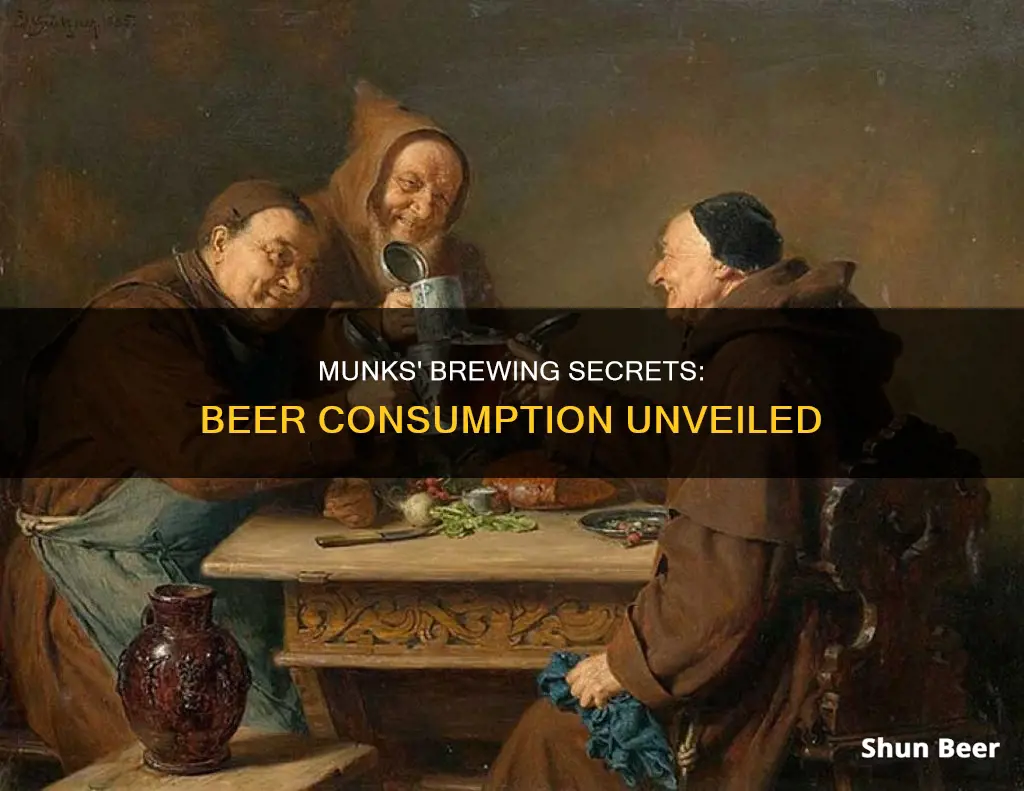
Monks have played a significant role in the history of beer brewing, with monastery breweries becoming prominent during the Middle Ages. Initially, monks brewed beer for their own consumption, but as they frequently hosted visitors, they shared their beer with travellers, too. Beer was also an important part of the monks' diet, as it was safer to drink than water, especially during Lent when they were restricted to small amounts of food. Monks were meticulous in recording their recipes, tracking each batch, and perfecting the process, which led to the creation of some of the world's finest beers. Today, monastic breweries continue to produce highly regarded beers, with some opening their doors to visitors who wish to sample their brews.
| Characteristics | Values |
|---|---|
| Monks drinking beer | Monks drank beer, and lots of it. |
| Beer brewing history | Monks did not invent beer but perfected it. |
| Beer as food | Beer was an important part of the monks' diet as it was safer than water. |
| Beer as medicine | Beer was permitted during Lent, when monks were not allowed to eat much, as it was full of calories. |
| Beer as an economic activity | Beer was economically important to monasteries. |
| Beer as a religious activity | Beer was considered a gift from God. |
| Beer as a social activity | Monks shared their beer with visitors. |
| Beer as a scientific activity | Monks recorded their recipes, documented every batch, and kept track of what worked and what didn't. |
| Beer as a charitable activity | Trappist monks brew beer to fund their charitable works. |
What You'll Learn

Beer was safer to drink than water
While it is a common belief that people in the past drank beer instead of water because the water was unsafe, this is not entirely true. In fact, drinking water was commonplace throughout history. The notion that water could carry diseases is a modern one; even the great sewers of Victorian London were designed to carry away "bad airs" rather than polluted water, which was thought to cause disease.
That being said, people in the Middle Ages did understand that water could be good or bad, and this was based on its smell and flavour. Those who could afford it would pay for good, clean water. For example, in 1237, the construction of the Great Conduit carried spring water from Tyburn to London, and water carriers (known as "cobs") supplied water in buckets to those who couldn't afford their own pipes.
However, beer was still an important part of the diet for many. During the Middle Ages, monasteries were important breweries, and monks were highly skilled beer brewers. They brewed beer for their own consumption and shared it with the frequent visitors to their monasteries. The beer they produced was of higher quality than what was available elsewhere, and it was also economically important. One Nuremberg monastery produced 300,000 litres of beer in a year.
Beer was also an important source of nutrition and calories, especially for those performing hard labour. It was also cheaper than wine, which was predominantly consumed by the upper classes. The beer of the time was also weaker than modern beer, with an ABV of around three percent, so people didn't drink it to get drunk. Instead, it was a nutritious and energy-providing choice, often referred to as "liquid bread".
So, while beer was not necessarily safer to drink than water, it did provide other benefits that made it a popular choice.
The Working of Beer Cup Filling Stations Simplified
You may want to see also

Monks drank beer during Lent
Monks have a special place in the history of beer brewing. They are known for having perfected the art of brewing beer, creating a product that many consider to be "divine". During the Middle Ages, monasteries were important breweries, and monks were highly skilled beer brewers who enjoyed their barley juice.
In the 17th century, monks, specifically the Paulaner monks in Bavaria, Germany, went on a unique Lenten fast. With the Pope's approval, they chose to consume only beer for the 40 days of Lent, abstaining from all solid foods. This approach, known as a "liquid diet" or "liquid bread", was a way to maintain their nutrition during the fasting period. Beer during that time contained less alcohol than it does today, and each monk was allowed up to five liters of beer per day.
The Paulaner monks brewed a special, unusually strong type of beer, a doppelbock, that was high in carbohydrates and nutrients. They wanted to ensure they fought off malnutrition during their fast. This beer eventually became the original product of the Paulaner brewery, founded in 1634, and was named "Salvator", derived from "Sankt Vater", meaning "Holy Father beer".
The monks were proud of their brew but worried that it was too delicious to be considered a Lenten sacrifice. Seeking guidance, they sent a barrel of their doppelbock to Rome for the Pope's approval. However, the beer spoiled during the long journey to Rome, and by the time it reached its destination, it tasted terrible. The Pope deemed that consuming it would be a sacrifice, and the monks happily continued to brew and drink it during Lent with clear consciences.
Beer Drinking: Is It in Your Genes?
You may want to see also

Beer was economically important to monasteries
Monasteries were important breweries during the Middle Ages. Monks were considered highly skilled beer brewers, and their beer was often of better quality than what was on offer elsewhere. Beer was also economically important to monasteries.
During the High Middle Ages, almost 500 monastery breweries were in operation, all flourishing enterprises. One Nuremberg monastery produced 300,000 liters of beer in a year. Today, only nine monastery breweries remain; most went bust after secularization. The two most famous are Andechs Monastery near Munich and Ettal Monastery near Oberammergau.
Initially, monks brewed beer for their own consumption and to give to guests, pilgrims, and the poor. Later, they started brewing for other people, such as noblemen, and sold their beer in "monastery pubs". There were also "church ales", or celebrations and feasts of the church, where peasants were allowed to drink beer for free, reducing the demand for commercial brewing.
Monks often drank large quantities of beer—up to five liters per day. This was partly because water in the Middle Ages was often polluted, so beer was healthier, and also because meals in monasteries were frugal, and beer provided a welcome nutritious addition. Beer was also used for spiritual and medicinal purposes and, as it was seen as a liquid like water, it was not forbidden during fasting periods.
Beer and Fatty Liver: Is There a Link?
You may want to see also

Monks' beer was superior in quality
Monks did not invent beer, but they certainly perfected it. During the Middle Ages, monasteries were important breweries, and monks were considered highly skilled beer brewers. The beer they brewed was of superior quality to what was available elsewhere.
There are several reasons why monks' beer was so good. Firstly, they could read and write, so they could record their recipes and improve them over time. This was a skill that set them apart from other brewers of the time.
Secondly, they had access to the best ingredients. Monasteries were self-sufficient, growing their own barley and other ingredients, and they had an abundance of pure water, which is essential for brewing good beer.
Thirdly, they had the time and dedication to perfect their craft. Brewing was a spiritual practice for monks, and they treated it as such, refining their techniques over centuries.
The beers produced by monastic breweries today are still considered some of the finest in the world. For example, the Weltenburger Dunkel, brewed by the monks of Weltenburg Abbey, is described as having a heavenly, creamy texture and a nutty, brown, earthy flavour.
In addition to their brewing expertise, monks also played an important role in the beer economy. During the High Middle Ages, almost 500 monastery breweries were in operation, and beer was an important source of income for monasteries.
Today, monastic beer is experiencing a renaissance, with new monastery breweries opening and old recipes being rediscovered. While there are far fewer monastic breweries now than in the past, the tradition of monastic brewing continues to shape the beer industry.
Enjoying Beer at VA Beach: What You Need to Know
You may want to see also

Monks' beer was freely shared with visitors
Monks have played a significant role in the history of beer brewing, and their breweries were once an important part of the Catholic monasteries of Europe. While monks initially brewed beer for their own consumption, they also freely shared it with visitors. Monasteries frequently received travellers and pilgrims, offering them hospitality in the form of shelter, food, and drink. As beer was considered safer to drink than water during this period, it was often the beverage of choice.
The practice of brewing beer in monasteries began during the Middle Ages, and these institutions became centres of brewing expertise. Monks meticulously recorded their recipes, tracked their brewing processes, and shared their knowledge as they moved between monasteries. This led to the development of specialised brewing techniques and the improvement of beer quality and consistency. The discovery that adding hops to the recipe acted as a preservative was a significant contribution by monks, allowing them to store beer in kegs and transport it to other communities.
The beer produced in monasteries was of higher quality than what was typically available elsewhere, and monks became renowned for their brewing skills. This reputation extended beyond the monastery walls, and several modern-day beer brands still bear names associated with religious orders, such as "Alpirsbacher."
Today, only a handful of monastery breweries remain, with most having closed down after secularisation. However, the legacy of monastic brewing lives on, and beers produced by monastic breweries are still considered some of the finest in the world. For beer enthusiasts, visiting a monastic brewery in Northern Europe can offer a unique opportunity to sample these renowned brews.
Dayquil and Beer: A Safe Mix?
You may want to see also
Frequently asked questions
Yes, monks do drink beer. In the Middle Ages, monks brewed beer in monasteries for their own consumption. Beer was also served to visitors and pilgrims.
In the Middle Ages, beer was safer to drink than water, especially during the many plagues that struck Europe. Monks also brewed beer to be self-sufficient and to fund their charitable works.
Trappist beer is brewed by Trappist monks. As of 2021, there are 13 Trappist monasteries that produce beer, 6 in Belgium, 2 in the Netherlands, and 1 each in Austria, Italy, England, France, and Spain. The International Trappist Association (ITA) assigns the Authentic Trappist Product label to breweries that meet their strict criteria.







